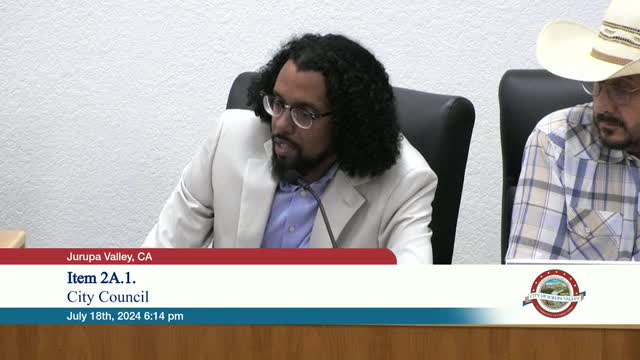City leaders push for transformative public transit solutions
July 18, 2024 | Jurupa Valley, Riverside County, California

This article was created by AI summarizing key points discussed. AI makes mistakes, so for full details and context, please refer to the video of the full meeting. Please report any errors so we can fix them. Report an error »

During a recent government meeting, officials discussed the pressing need for improved public transportation options and urban design strategies aimed at enhancing community livability. A key point raised was the growing anxiety among residents regarding freeway driving, highlighting a potential demand for more convenient public transit alternatives.
Commissioners expressed their dissatisfaction with current bus stop conditions, noting that many are uninviting and poorly maintained. They emphasized the importance of integrating public transit planning with ongoing street redesign efforts, suggesting that collaboration with the Regional Transit Authority (RTA) could facilitate the addition of bus stops in areas where they are most needed.
The conversation also touched on the concept of \"road diets,\" a traffic management strategy that involves reducing the number of lanes on a roadway to create space for bike lanes and wider sidewalks. This approach aims to enhance safety for pedestrians and cyclists, particularly in areas with lower traffic volumes. Officials acknowledged that while road diets can be controversial, they are essential for creating safer urban environments.
Additionally, the meeting highlighted the significance of landscaping and greenery in urban planning. One commissioner lamented the loss of tree-lined streets and advocated for the reintroduction of trees to improve community aesthetics and comfort, especially in hot climates.
The discussion concluded with a call for more inclusive branding that reflects the community's equestrian heritage, suggesting that future city logos incorporate equestrian imagery to better represent local culture.
Overall, the meeting underscored a collective commitment to improving public transit, enhancing urban design, and fostering a more inviting community atmosphere.
Commissioners expressed their dissatisfaction with current bus stop conditions, noting that many are uninviting and poorly maintained. They emphasized the importance of integrating public transit planning with ongoing street redesign efforts, suggesting that collaboration with the Regional Transit Authority (RTA) could facilitate the addition of bus stops in areas where they are most needed.
The conversation also touched on the concept of \"road diets,\" a traffic management strategy that involves reducing the number of lanes on a roadway to create space for bike lanes and wider sidewalks. This approach aims to enhance safety for pedestrians and cyclists, particularly in areas with lower traffic volumes. Officials acknowledged that while road diets can be controversial, they are essential for creating safer urban environments.
Additionally, the meeting highlighted the significance of landscaping and greenery in urban planning. One commissioner lamented the loss of tree-lined streets and advocated for the reintroduction of trees to improve community aesthetics and comfort, especially in hot climates.
The discussion concluded with a call for more inclusive branding that reflects the community's equestrian heritage, suggesting that future city logos incorporate equestrian imagery to better represent local culture.
Overall, the meeting underscored a collective commitment to improving public transit, enhancing urban design, and fostering a more inviting community atmosphere.
View full meeting
This article is based on a recent meeting—watch the full video and explore the complete transcript for deeper insights into the discussion.
View full meeting
